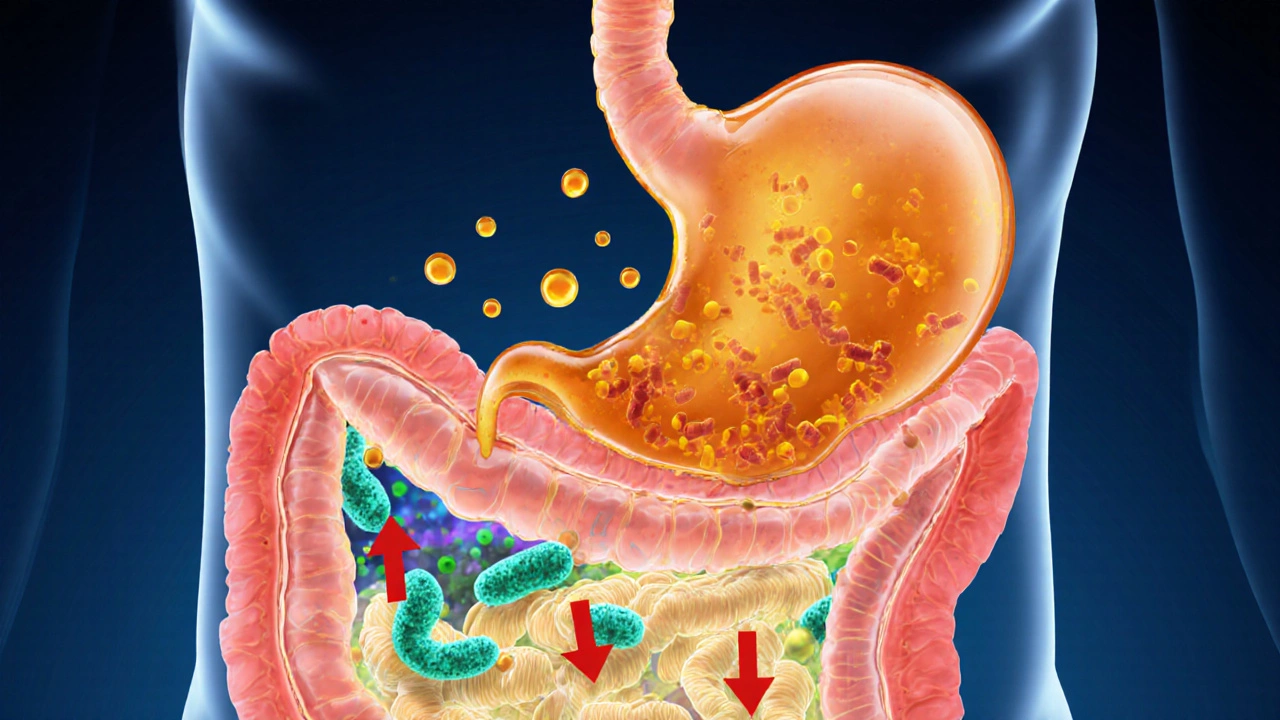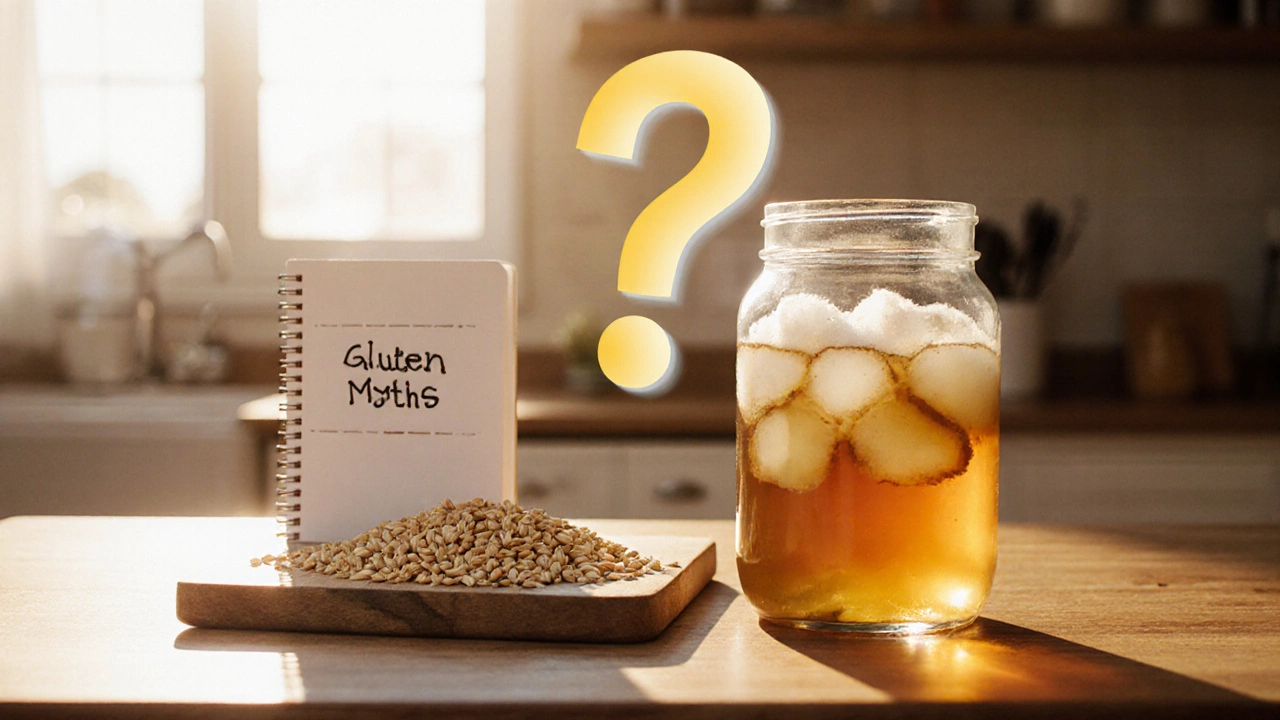Apple Cider Vinegar and Gluten Intolerance Calculator
When you read headlines that claim a kitchen staple can "cure" gluten issues, you probably wonder if there’s any truth to it. The short answer: apple cider vinegar (ACV) isn’t a magic bullet, but it does have properties that may ease some symptoms for people with gluten intolerance. Below we break down the science, the practical uses, and the limits, so you can decide whether a splash of ACV belongs in your daily routine.
What Exactly Is Gluten Intolerance?
Gluten intolerance is a broad term that covers two main conditions: celiac disease, an autoimmune reaction that damages the small‑intestine, and non‑celiac gluten sensitivity, which triggers discomfort without the same immune response. Both involve an adverse reaction to the protein gluten found in wheat, barley, and rye.
Typical symptoms range from bloating, gas, and abdominal pain to fatigue, joint aches, and skin rashes. The root problem is that gluten can trigger inflammation and, in celiac disease, flatten the villi that line the intestine, impairing nutrient absorption.
Apple Cider Vinegar: What It Is and How It Works
Apple cider vinegar is a fermented liquid made from crushed apples, yeast, and bacteria. The fermentation process converts sugars into ethanol and then into acetic acid, the component that gives ACV its sharp taste and many of its touted health benefits.
Key attributes of ACV include:
- Acetic acid concentration of 4‑6%.
- Small amounts of potassium, magnesium, and vitamin C.
- Live probiotic cultures when you choose the raw, unfiltered variety with the "mother" strands.
Research shows ACV can modestly lower post‑meal blood glucose, improve satiety, and support a slightly more acidic stomach environment, which may aid protein digestion.

How ACV Might Influence Gluten‑Related Symptoms
There are three primary ways ACV could intersect with gluten intolerance:
- Enhancing Stomach Acidity: Adequate acid helps break down proteins, including gluten fragments. Some people with low stomach acid report better digestion after a tablespoon of ACV diluted in water before meals.
- Supporting Gut Microbiota: The probiotic strains in raw ACV can contribute to a healthier gut microbiome. A balanced microbiome may reduce inflammation and improve barrier function, potentially easing non‑celiac sensitivity.
- Reducing Inflammation: Acetic acid has mild anti‑inflammatory effects in animal studies. While human data are limited, lowering systemic inflammation could lessen the severity of symptoms after accidental gluten exposure.
It’s important to note that these mechanisms are supportive, not curative. ACV does not repair damaged intestinal villi, nor does it stop the immune system from reacting to gluten in celiac disease.
Scientific Evidence - What Studies Say
Direct research on ACV and gluten intolerance is scarce. However, a few related findings help frame the picture:
- A 2019 pilot study on digestive enzymes showed that adding acidifiers (including vinegar) improved protein breakdown in low‑acid participants, reducing bloating after high‑protein meals.
- A 2020 review of probiotic foods highlighted that raw ACV can increase populations of Lactobacillus species, which are linked to lower gut permeability (often called "leaky gut").
- Human trials on ACV’s effect on blood sugar suggest a modest reduction in post‑prandial spikes, which can indirectly help people with celiac disease who struggle with glucose regulation.
Overall, the evidence leans toward ACV being a low‑risk adjunct that may ease mild digestive discomfort, but it doesn’t replace a strict gluten‑free diet or medical treatment.
Practical Ways to Use Apple Cider Vinegar
If you decide to try ACV, keep these guidelines in mind:
- Start Small: Mix 1tsp (5ml) of raw ACV with 8oz (240ml) of water. Sip it 20 minutes before a meal. Gradually increase to 1-2tbsp per day if you tolerate the acidity.
- Choose Raw, Unfiltered: The "mother" contains live cultures that offer the probiotic benefit. Filtered or distilled ACV loses most of that advantage.
- Don’t Overdo It: Excessive acidity can erode tooth enamel and irritate the throat. Rinse your mouth with water afterward or use a straw.
- Combine with Other Gut‑Friendly Foods: Pair ACV with a serving of fermented vegetables, kefir, or a gluten‑free probiotic supplement for a synergistic effect.
- Track Your Symptoms: Keep a simple log of meals, ACV dose, and any changes in bloating, pain, or energy. This helps you see if the routine actually helps you.
Below is a quick reference table to compare ACV with a few other natural remedies that people often consider for gluten‑related discomfort.
| Remedy | Primary Action | Evidence Level | Typical Dose |
|---|---|---|---|
| Apple Cider Vinegar | Acidifies stomach, adds probiotics | Low‑to‑moderate (small studies) | 1-2tbsp diluted daily |
| Digestive Enzyme Supplements | Breaks down proteins & carbs | Moderate (clinical trials) | 1capsule with each meal |
| Probiotic Yogurt (dairy‑free) | Boosts beneficial bacteria | Moderate (meta‑analysis) | ½cup daily |
| Ginger Tea | Anti‑inflammatory, anti‑nausea | Low (pilot studies) | 1‑2cups per day |

When ACV Might Not Be Right for You
There are a few scenarios where you should skip the vinegar dose:
- If you have a diagnosed celiac disease, ACV cannot reverse intestinal damage. Focus on a strict gluten‑free diet and medical follow‑up.
- People with a history of acid reflux, gastritis, or stomach ulcers may find the extra acidity aggravates symptoms.
- Those on potassium‑lowering medications (e.g., certain diuretics) should monitor intake, as raw ACV contains potassium.
- Pregnant or breastfeeding individuals should consult a healthcare professional before adding regular ACV doses.
Putting It All Together: A Sample Day
Here’s a realistic schedule that weaves ACV into a gluten‑free lifestyle without turning it into a gimmick:
- Morning: Warm water with 1tsp ACV, followed by a gluten‑free oatmeal topped with berries.
- Mid‑morning snack: A small cup of coconut‑based kefir (provides extra probiotics).
- Lunch: Grilled chicken salad with mixed greens, carrots, and a drizzle of olive oil. Before eating, sip another 1tsp ACV‑water mix.
- Afternoon: Ginger tea if you feel any bloating.
- Dinner: Baked salmon, quinoa, and steamed broccoli. Finish with a glass of water-no ACV needed if you already had two doses earlier.
- Evening: Record any symptoms in your log and note whether the ACV seemed to help.
This routine keeps the ACV dose low, pairs it with other gut‑friendly foods, and ensures you still prioritize a completely gluten‑free diet.
Frequently Asked Questions
Can ACV cure celiac disease?
No. Celiac disease is an autoimmune condition that requires a lifelong gluten‑free diet. ACV may help with mild digestive discomfort, but it does not repair intestinal damage or stop the immune response.
Is raw, unfiltered ACV safe for daily use?
Generally yes, as long as you dilute it (1tsp‑1tbsp in water) and don’t exceed 2tbsp per day. People with acid‑related stomach issues should start with a smaller dose.
How does ACV compare to probiotic supplements?
Probiotic capsules usually contain higher concentrations of specific strains with proven benefits. Raw ACV offers a modest probiotic boost and the added effect of acetic acid, making it a complementary, not a replacement, option.
Will ACV help with bloating after accidental gluten exposure?
Some people report reduced bloating when they take ACV before a meal, likely because the extra acidity improves protein breakdown. Results vary, so keep a symptom log to see if it works for you.
Can I mix ACV with other remedies like digestive enzymes?
Yes. Combining a low‑dose ACV drink with a digestive enzyme capsule taken at the same time can give a two‑pronged boost-acidic environment plus targeted enzymes. Always follow label instructions and monitor how you feel.

